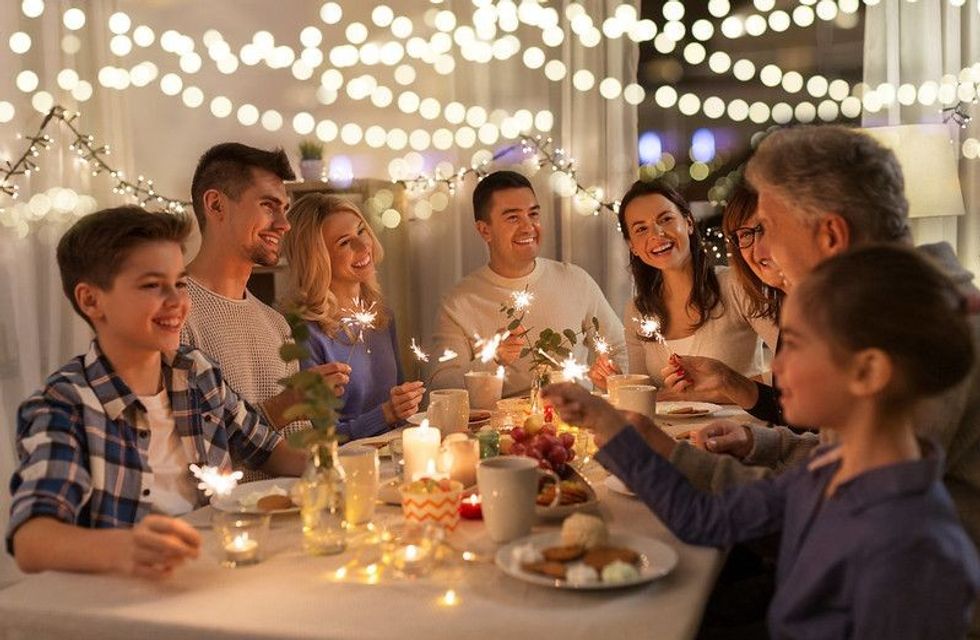31 Fun Facts About Thanksgiving To Share With Your Family

We are here to save you from any awkward silence during your first Thanksgiving dinner or entertain and educate your family with some interesting facts about this national holiday.
For getting you started, here is a fun fact: the wishbone tradition is older than you think (much older!). The wishbone tradition is the practice where two people tug on either side of the frail bone while silently making a wish, and whoever ends up with the larger piece of the bone gets their wish granted.
This practice originated among the Etruscan civilization in 322 BC, traveled to England during the Roman conquest, and ended up in America via the English colonists. Another curious fact is that the iconic Macy's Thanksgiving Day debut parade didn't have your favorite character balloons.
Instead, they had something even wilder (quite literally!). The annual Macy's Thanksgiving Day parade is the world's largest parade held in New York City.
The parade is hosted by the US-based departmental store chain known as Macy's. Macy's Thanksgiving Day parade marches its 2.5 mi (4 km) route starting from 77th street and Central Park West at 9 am on Thanksgiving morning and ends in front of Macy's Herald Square on 7th Avenue.
So, this holiday season, give a spark to those boring conversations and indulge in some fascinating (and weird!) facts. And if it is your first Thanksgiving dinner, it may just help you leave a great first impression!
Read on to unravel the mystery of Macy's debut Thanksgiving parade and how turkey was almost declared a national bird. You may also be interested in these fun fact articles Christmas in Germany, and facts about Cuba.
History Of Thanksgiving
Thanksgiving Day is an annual national holiday in the USA and Canada to celebrate the harvest of the past year. Thanksgiving Day is celebrated on the fourth Thursday of November every year as specified by Congress after passing a joint resolution in 1941. In 1942, the then-president of the United States, Franklin D. Roosevelt, proclaimed the same.
Canadian Thanksgiving is celebrated on the second Monday of October every year since January 31, 1957, after the Canadian parliament's declaration. Before this fixed date, Canadians used to celebrate Thanksgiving intermittently as a tribute to the blessings of a good harvest, military success, and safe journeys.
Even though in 1879, Thanksgiving was officially declared a national holiday to be held on November 6, the Thanksgiving holiday often coincided with other major events and anniversaries, especially after the First and Second World Wars.
After the First and Second World wars, November 11 was chosen as Remembrance day. Since the two holidays should not fall on the same weekend, the date was moved to October. As it turns out, the date is more fitting because the end of harvest season is October in most parts of Canada.
Thanksgiving history in the United States is believed to be modeled on the harvest feast of 1621 which was shared by the Pilgrims of Plymouth (English Colonists) and the Wampanoag people (Native Americans who formerly occupied parts of Rhode Island and Massachusetts).
Plymouth’s Thanksgiving or harvest feast promptly began with a few colonists going out hunting for easy prey like ducks or hens. The Wampanoag Native Americans paid a surprise visit to the colonist settlement area, it was located in the Wampanoag territory, and unnerved the smaller population of English colonists.
However, the two groups socialized and even contributed to the feast.
The Wampanoag people contributed fishes, eels, vegetables, stews, and beer. Despite the language barrier, the men enjoyed each other's company by firing guns, running races, and drinking beer together.
This simple and yet, chaotic affair led to a peace treaty between the two groups that lasted until King Philip's war.
The Wampanoag high chief, Massasoit, made a peace treaty with the Pilgrims in 1620 which was observed until the death of the high chief.
The mistreatment of tribal people and tribal land by the English settlers drove the son of the high chief, Metacom (King Philip), to form alliances with other tribal groups so they could drive out the colonists. Unfortunately, the allied tribes were defeated in the war.
King Philip's war is also known as the Great Narragansett War, and it is one of the bloodiest conflicts in US history with over 100 Native Americans and hundreds of colonists lives lost.
These colonists, who were already accustomed to celebrating Thanksgiving as a prayer or celebration, gave rise to the tradition of Thanksgiving in the United States.
However, it wasn't made official due to several religious disparities among the American people. Continental Congress of the US proclaimed Thanksgiving as a federal holiday upon the enactment of the US Constitution, but later in 1798, the US Congress left the declarations to the states with regard to religious conflicts.
It wasn't until Abraham Lincoln (the then-president of the US) on October 3, 1863, officially announced the celebration of Thanksgiving as a national holiday on November 26.
Canadian Thanksgiving is a little different to the American one.
Even though the tradition of Thanksgiving long existed in Indigenous culture to celebrate the fall harvest, Sir Martin Frobisher (a British explorer) was the first European settler who celebrated Thanksgiving in Canada.
Frobisher and his crew were grateful for their lives after escaping deadly storms in the Arctic, and therefore had a feast (nothing grand, just salted beef and peas) as a way of showing their thankfulness.
This resulted in a series of events that ultimately led to a tradition of Thanksgiving celebrated on the second Monday of October.
In both countries, the United States and Canada, Thanksgiving is celebrated with close friends and family members who often gather together for a warm Thanksgiving meal. This has led to it being the busiest day in terms of vehicle traffic.
Thanksgiving food usually consists of eating turkey, stuffed bread, and mashed potatoes with pumpkin pies and cranberry sauce.
A traditional and full Thanksgiving meal has more than a few main and side dishes which includes corn on the cob, green bean casserole, candied yams, roast turkey, stuffed turkey, gravy, cornbread dressing, and dinner rolls along with the usual desserts like pumpkin pie or pecan pie served with cranberry sauce.
Why is Thanksgiving celebrated?
Thanksgiving is the annual national holiday celebrated nationwide in the United States and Canada to pay tribute to the blessings of the fall harvest and other blessings. It is celebrated on the fourth Thursday of November every year in the United States. In Canada, it is celebrated on the second Monday of October every year.
It is believed that the American Thanksgiving is modeled after the harvest feast of 1621 celebrated between the Native Americans and English colonists (pilgrims of Plymouth). Both groups enjoyed a heartfelt feast with beers, chicken, fish, ducks, and swans.
Turkey was not eaten at the first Thanksgiving feast. Though turkeys were found in abundance near the location, they were not the trophies of the dinner table.
The two groups sat outside the Plymouth buildings on the ground and drank beer, ran races, and ate together. This sealed a treaty between the two groups and the tradition continued until King Philip's war.
On Thanksgiving, Americans eat a lavish feast consisting of roasted turkey or stuffed turkey with cornbread dressing, mashed potato, corn on the cob topped with melted butter, green bean casserole, gravy, and cranberry sauce. For dessert, pumpkin pie and pecan pie are served.
Thanksgiving originally was celebrated for the blessings of the fall harvest, military success, and safe journeys. Nowadays, Thanksgiving is enjoyed as the day to be thankful or grateful for every comfort your life has. After the big meal, many families gather together around the television to watch the football game.

Weird Facts About Thanksgiving
Thanksgiving may be a traditional holiday but it has its fair share of weirdly fascinating Thanksgiving facts! And we bet you do not know at least one of the following Thanksgiving facts.
Most Americans eat Turkey on Thanksgiving, and it is considered the staple food of the occasion. But the first Thanksgiving dinner hosted in 1621 had no turkeys or at least, historians have found no records of it.
Instead, people were served with other meat like deer, ducks, chickens, fish, lobsters, and swan. The first Thanksgiving was also a three-day affair unlike how it is celebrated today.
It wasn't until Abraham Lincoln made the event a national holiday during his tenure as the president that all the previous presidents had to announce Thanksgiving as a holiday every single year.
However, President Thomas Jefferson refused to acknowledge Thanksgiving as a holiday during his tenure due to his religious beliefs that the church and the state should remain separate.
He also believed that Thanksgiving should be a state holiday instead of a national one.
You will be surprised to know that the personality behind 'Mary Had A Little Lamb' has something to do with Thanksgiving being designated as a federal holiday.
The writer of 'Mary Had A Little Lamb', Sara Josepha Hale is considered the Mother of Thanksgiving. It was her three decades of constant persistence that managed to convince President Abraham Lincoln to proclaim Thanksgiving as a national holiday.
She was the founder of 'American Ladies Magazine' where she published several articles advocating for the nationwide occasion to act as a unifying symbol and help unite the southern and the northern states.
It wouldn't be a good Thanksgiving day with no Macy's Thanksgiving Day parade. Macy's Thanksgiving Day parade was originally known as Macy's Christmas parade, and it debuted in 1924.
Today, Macy's Thanksgiving Day parade is well known for its floating balloon characters, singers, puppets, and celebrities but the very first parade also featured something wilder: animals from the Central Park Zoo. Elephants, monkeys, camels, and bears of the zoo got to march in the first parade in New York City.
In 1939, President Roosevelt wanted to boost the economy during this favorite holiday by moving it a week ahead. Instead of celebrating it on the fourth or last Thursday of November as Lincoln pleased, Roosevelt allocated the third Thursday for the celebration.
Though, due to mass dissatisfaction with the change of dates, it was officially switched back to the original date in 1942.
It was a dearest wish of the founding father of the United States, Benjamin Franklin, to declare the turkey as the national bird rather than the bald eagle. He wrote to his daughter expressing his wishes of having a turkey be the representative of the country because it is a more respectable bird.
Imagine having to eat the national bird as your Thanksgiving big meal!
Most Americans spend their Thanksgiving with a joyous meal and watch the football game. Since the American football game is the biggest North American sport, watching football on the national day of Thanksgiving comes as no surprise and it has become a tradition now. The first football game played on Thanksgiving day was held in 1920.
Roasting a big bird one time a year sounds a little intimidating especially for first-timers, doesn't it? Apparently, the Butterball Turkey Talk Line had the same thought and came to our rescue.
The Turkey talk line was founded in 1981 when a bunch of home economists decided to help other people in cooking delicious turkey.
From answering about 11,000 questions during their first year to answering almost a whopping 100,000 questioning calls every holiday season! So, if your frozen turkeys are not roasting the way you want, professional help is just a phone call away.
Thanksgiving Day also had an anthem. It was actually the well-known now-Christmas anthem, 'Jingle Bells'. The 1857 song, 'Jingle Bells' was originally titled 'One Horse Open Sleigh', and its composer, James Pierpont, wanted it to be a Thanksgiving song but it became so popular around December 25 that it was renamed to what it is today.
TV dinners, also called frozen meals or microwave meals, was a term coined by inventor Gerry Thomas during the 20th century. During his time, televisions were a growing medium and were considered high status.
The idea of a TV dinner was to produce pre-packaged food which can be reheated easily and were very convenient. But the concept of TV dinners has its association with Thanksgiving.
In 1953, a Swanson employee miscalculated and ordered an excess of over 260 tons (235,868 kg) of frozen turkeys.
So, rather than making a loss by throwing out all the excess, Swanson salesman Gerry Thomas ordered 5000 aluminum trays and served turkeys with cornbread dressing, sweet potatoes, gravy, and peas at the price of 98 cents (98 pence). This led to the invention of frozen meals.
The 41st President George H.W. Bush was the first to pardon the turkey on Thanksgiving in 1989 during his official Thanksgiving announcement. This tradition was then maintained by the rest of the presidents.
Last but not least, the Thanksgiving tradition of turkey trots. A turkey trot race is an energetic and fun footrace that is held each year on or before Thanksgiving and attracts multiple participants who are looking to burn some pre-dinner calories.
Many trot races are held weeks before Thanksgiving to raise money for charities. The range for these races can be anywhere from 3.1-26.2 mi (5-42 km). There are different prizes for the winners as well such as cash prizes, turkey-designed clothes, accessories, and even frozen turkeys!
An average American gains approximately 3000 calories and this can even reach almost up to 4500 calories after eating a Thanksgiving dinner. These statistics are more believable when you realize that around 46 million turkeys are consumed each Thanksgiving according to the US poultry and Egg Association.
Add to it the fact that turkey sold in grocery stores weighs around 30 lb (13 kg).
Why is it called Thanksgiving?
Thanksgiving Day is celebrated across the United States on the fourth Thursday of November and across Canada on the second Monday of October. It is modeled on the harvest feast of 1621 between the Pilgrims of Plymouth (English settlers) and Native Americans.
The pilgrims already celebrated days of Thanksgiving as a tribute to good harvest and it was a part of their religion. These were days of prayers and not of feasting.
It was President Abraham Lincoln who announced the official Thanksgiving Day on October 3, 1863, to express his gratitude over the victory of the Union Army at Gettysburg. Today, American families celebrate the day with a lavish feast, watching footfall and expressing thankfulness for all the good in their lives.
It is a way of giving thanks to someone or something you are grateful for. This is why it is called Thanksgiving.
Here at Kidadl, we have carefully created lots of interesting family-friendly facts for everyone to enjoy! If you liked our suggestions for Facts about Thanksgiving, then why not take a look at Christmas in Mexico, or facts about Alaska.
We Want Your Photos!
More for You
See All
Bachelor of Arts specializing in Linguistics

Martha MartinsBachelor of Arts specializing in Linguistics
Martha is a full-time creative writer, content strategist, and aspiring screenwriter who communicates complex thoughts and ideas effectively. She has completed her Bachelor's in Linguistics from Nasarawa State University. As an enthusiast of public relations and communication, Martha is well-prepared to substantially impact your organization as your next content writer and strategist. Her dedication to her craft and commitment to delivering high-quality work enables her to create compelling content that resonates with audiences.
Disclaimer
1) Kidadl is independent and to make our service free to you the reader we are supported by advertising. We hope you love our recommendations for products and services! What we suggest is selected independently by the Kidadl team. If you purchase using the Buy Now button we may earn a small commission. This does not influence our choices. Prices are correct and items are available at the time the article was published but we cannot guarantee that on the time of reading. Please note that Kidadl is a participant in the Amazon Services LLC Associates Program, an affiliate advertising program designed to provide a means for sites to earn advertising fees by advertising and linking to Amazon. We also link to other websites, but are not responsible for their content.
2) At Kidadl, we strive to recommend the very best activities and events. We will always aim to give you accurate information at the date of publication - however, information does change, so it’s important you do your own research, double-check and make the decision that is right for your family. We recognise that not all activities and ideas are appropriate for all children and families or in all circumstances. Our recommended activities are based on age but these are a guide. We recommend that these ideas are used as inspiration, that ideas are undertaken with appropriate adult supervision, and that each adult uses their own discretion and knowledge of their children to consider the safety and suitability. Kidadl cannot accept liability for the execution of these ideas, and parental supervision is advised at all times, as safety is paramount. Anyone using the information provided by Kidadl does so at their own risk and we can not accept liability if things go wrong.
3) Because we are an educational resource, we have quotes and facts about a range of historical and modern figures. We do not endorse the actions of or rhetoric of all the people included in these collections, but we think they are important for growing minds to learn about under the guidance of parents or guardians.







